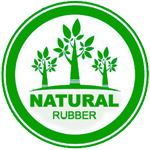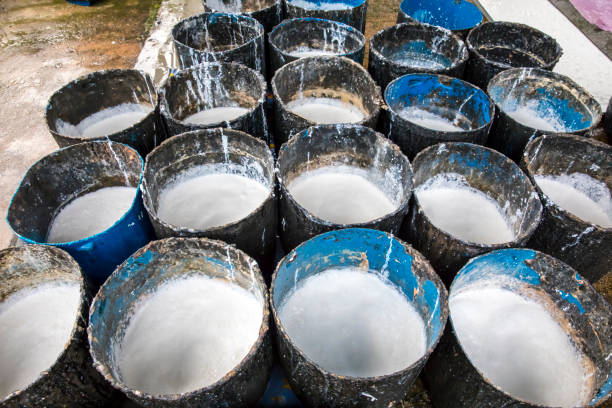WHAT IS THE DIFFERENCE BETWEEN LATEX AND RUBBER?
The words “latex” and “rubber” are used together so frequently that some people assume they’re interchangeable. Many even wonder, “Is latex rubber?” However, latex and rubber are two different materials, and there are numerous variations of each to consider.
WHAT IS LATEX
Many people think latex is another word for rubber. But latex and rubber are not the same thing. Latex is a milky white substance that may be used in production as is or collected, treated, and processed to become rubber.
WHERE DOES LATEX COME FROM?
Latex can be loosely classified into two categories: natural latex and synthetic latex.
Natural latex is produced by many flowering plants, including Hevea brasiliensis, the “rubber tree.” The milky white latex is found directly under the bark of the rubber tree and is harvested via careful tapping methods that have been perfected over many years.
Synthetic latex, however, is made entirely by humans. Most synthetic latex is made from styrene and butadiene, two common petroleum compounds, but other petrochemicals may be used. Synthetic latex mimics many of the most desirable properties of natural latex. It’s also worth noting that synthetic latex is usually safe for people who are sensitive or allergic to natural latex.
USES OF LATEX
Most latex is processed into rubber, but latex has many uses as a pure substance.
Synthetic latex is in high demand for use in coatings, paints and glues. The polymer particles in the latex coalesce and solidify as the substance dries, creating a protective film that is safe for the environment. Synthetic paints and coatings are especially popular for outdoor use.
Latex may also be used in clothing, chewing gum, and drug development.
WHAT IS RUBBER
Rubber is a polymeric substance that can be loosely categorized into three types:
NATURAL RUBBER
Natural rubber is the product of natural latex and offers many highly desirable properties. It’s strong, flexible, and durable. Rubber holds up well against wear and tear, such as abrasion, fatigue, and exposure to water and certain chemicals. Every natural rubber product will have a slightly different composition profile based on its service environment, but natural rubber ingredients include latex, acids, chemicals, and additives.
SYNTHETIC RUBBER
Synthetic rubber is made from synthetic latex, which comes from petroleum byproducts. Synthetic rubber is fairly easy to produce and readily available. While there are many similarities between synthetic rubber and natural rubber, there are a few key differences between the two. Synthetic rubber is more resistant to abrasion, grease, oil, and heat when compared to natural rubber. In fact, some varieties of synthetic rubber are even flame resistant. Like natural rubber, synthetic rubber is highly flexible, but synthetic rubber maintains that flexibility even at low temperatures. With the right manufacturing methods, synthetic rubber can also be highly resistant to extreme temperatures and corrosion.
SILICONE RUBBER
Silicone rubber, like natural rubber, is an elastomer. The difference between the two lies in their atomic structure. Most rubbers have backbones made of carbon-carbon bonds, but silicone’s backbone is made of silicon and oxygen. Silicone is typically non-reactive, stable, and resistant to extreme environments. Silicone rubber holds up much better than natural rubber against heat, cold, chemicals, and ozone. Silicone also can handle long-term water exposure with very little absorption or other impact on mechanical properties. Other benefits include biocompatibility and radiation resistance.
HOW IS RUBBER MADE?
The manufacturing processes for natural rubber and synthetic rubber are slightly different.
Natural rubber is made from natural rubber latex, which is harvested from rubber trees. The milky white latex is first treated with a coagulating agent and dried. The dried material is then exposed to heat, which triggers a process called vulcanization. Additives may also be introduced at this stage to enhance material properties, improve durability, or increase resistance to environmental stressors.
Synthetic rubber is also the product of coagulation and heat. However, the synthetic rubber manufacturing process starts with a hydrocarbon mixture, usually from oil or coal. This mixture is refined to produce naphtha, a flammable oil. The naphtha is combined with natural gas to create monomers, such as butadiene, styrene, isoprene, chloroprene, ethylene, and propylene. This substance is then polymerized using a catalyst and process steam, forming chains of polymers to create rubber. At this stage, the synthetic rubbers can be further vulcanized if needed.
Silicone rubber starts with silica, a silicone dioxide compound. Silica can be found throughout the natural world but is most easily extracted from quartz sand. Huge quantities of quartz sand are heated up to 1800°C to extract silicon atoms. The pure silicon is then combined with methyl chloride, exposed to heat, and distilled into polydimethylsiloxane. Final steps of the process include polymerization, molding or extrusion, and curing.
USES FOR RUBBER
Natural rubber can be found in thousands of different products, from industrial components to everyday consumer items, including hoses and belts, medical devices, protective gloves, and children’s toys. The tire industry consumes a large portion of the world’s natural rubber supply, and both natural and synthetic rubbers can be found through most vehicles.
There are many types of synthetic rubber, and their uses are largely informed by their unique properties. For example, polyisobutylene rubber, or “butyl,” has excellent damping properties and is commonly used to make massive seismic absorbers for skyscrapers in cities prone to earthquakes. Ethylene propylene diene rubber (EPDM) holds up well against environmental factors, making it a popular choice for weather stripping, roofing, and all kinds of seals. Styrene butadiene rubber (SBR) is a good all-purpose synthetic rubber and can be found in tires, shoe soles, and more. The applications for synthetic rubber are virtually unlimited.
Silicone rubber doesn’t degrade in high temperatures and is food safe, making it a popular choice for cooking and baking tools. Silicone muffin tins, spatulas, and many other tools have become increasingly popular in recent years. Many other consumer products contain silicone, such as sportswear, storage containers, electronics, cosmetics, and footwear. Industry uses for silicone include automotive products, sealants, and insulators. Silicone can also be found in many medical products, such as tubing, syringe components, fluid management components, and more.


Your article helped me a lot, is there any more related content? Thanks!
Your point of view caught my eye and was very interesting. Thanks. I have a question for you.
Thanks for sharing. I read many of your blog posts, cool, your blog is very good.
I don’t think the title of your article matches the content lol. Just kidding, mainly because I had some doubts after reading the article.
Thank you for your sharing. I am worried that I lack creative ideas. It is your article that makes me full of hope. Thank you. But, I have a question, can you help me?
Your point of view caught my eye and was very interesting. Thanks. I have a question for you.